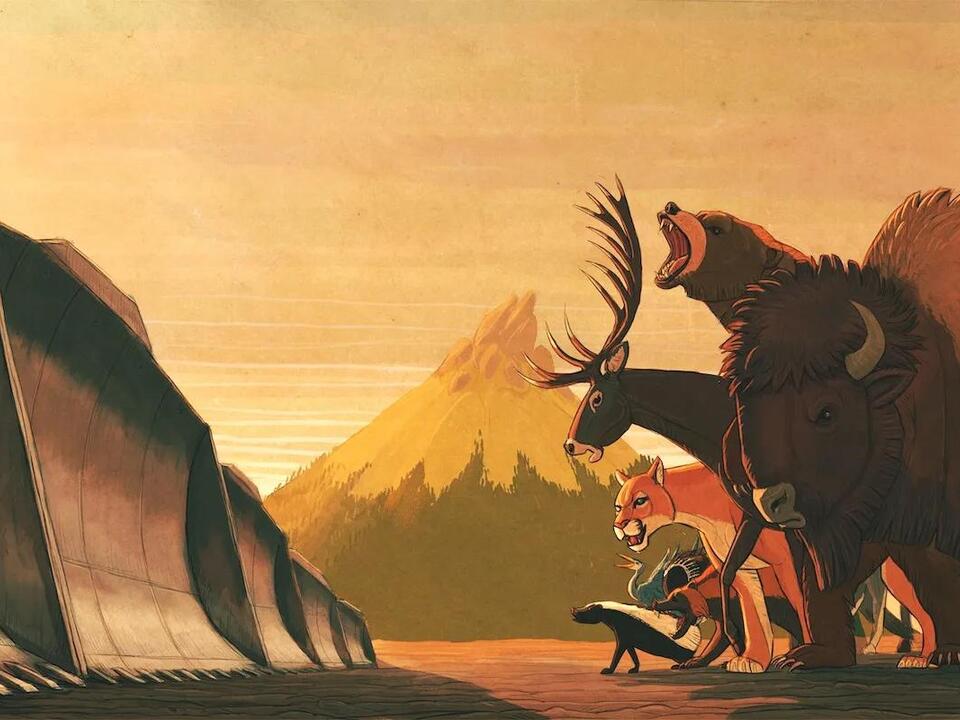Physical Address
304 North Cardinal St.
Dorchester Center, MA 02124
Physical Address
304 North Cardinal St.
Dorchester Center, MA 02124

Every culture has its creation myths, from the Mayans’ “Popol Vuh” to the two separate accounts found in the Judeo-Christian book of Genesis. These stories reveal a common desire: to understand our existence within a larger plan orchestrated by a higher power. The Hungarian animated feature, “Four Souls of Coyote,” directed by Áron Gauder, offers another take on creation, focusing on the origin of Turtle Island (now known as North America) and its inhabitants, including humans. This tale is shared by various Northeastern Indigenous peoples in North America.
In the present-day frame narrative, an unscrupulous oil company is eager to start a pipeline project, disregarding environmental concerns. A diverse group of protesters, both Native American and otherwise, fights to halt the groundbreaking. Among them, an elderly Indigenous man recounts an ancient myth. He speaks of the Old Man Creator, voiced by Indigenous Canadian actor Lorne Cardinal, who crafted the world from dreams, emerging from the mysterious spirit. From nothingness comes water, followed by a duck that provides the Old Man Creator with the material to mold the land and its animals. The character’s playful manipulation of the frame adds an unexpected touch to the animation.
The Old Man Creator’s angular design makes the ridges on his face resemble a woodcarving, contributing to the animation’s earthy feel. Other characters also possess a handcrafted appearance, distinguishing the film from other European animated works while aligning it visually with themes of nature and respect. Gauder’s team used a blend of hand-drawn characters, painterly backgrounds, and computer-generated elements to bring this mythology to life.
Midway through the film, the Old Man Creator’s anger gives birth to lighting, depicted as a flying, talking snake designed to look like a pencil sketch. This rudimentary design emphasizes the instinctual quality of our most primitive impulses.
In another dream, the Old Man Creator observes four mischievous coyotes symbolizing disobedience. He merges them into a single entity, Coyote, voiced humorously by Diontae Black, giving it four lives before banishment. Driven by hunger, Coyote creates Man (Danny Kramer) and Woman (Stephanie Novak) from the same material the Old Man used. However, the Old Man prevents Coyote from eating and assigns it the role of caretaker since humans are weaker than other creatures. Gauder had utilized Coyote in his previous animated shorts.
Coyote’s insatiable appetite and scheming nature recall Chuck Jones’ Wile E. Coyote. His arrogance, eventual humility, and ultimate sacrifice illustrate that humans’ roles in the grand scheme are no more significant than other creatures. Coyote serves not as a villain but as a chaotic agent of change, grounding wisdom in his journey.
During the folk tale, the Old Man Creator holds an assembly where animals, initially unable to reproduce, demand companionship within their species. This harmonious relationship presents an idealized vision of reality. The film’s soulful score, featuring Native American music groups like Ulali and Northern Cree, along with artist Joanne Shenandoah, adds spiritual gravitas to the project.
Surprisingly, the film is a Hungarian production with no obvious ties to its source material. The Hungarian-dubbed version was the country’s entry for Best International Feature Film at the Oscars last year. An English-language version is currently showing in the U.S. Gauder explained that inspiration partly came from Hungarian singer Tamás Cseh, who translated Native American folktales into Hungarian and popularized them. These were published with illustrations by his son.
With Native American consultants’ help, Gauder and co-writer Géza Bereményi struck a balance between solemnity and amusement, mainly derived from Coyote’s antics. While “Four Souls of Coyote” may grapple with its ambition and overly-tidy conclusion, its handcrafted aesthetic and enduring ancestral wisdom provide a captivating experience.
Source: Particle News



